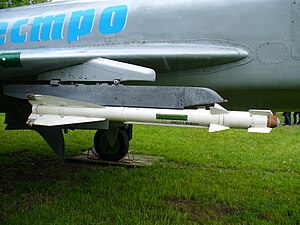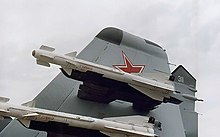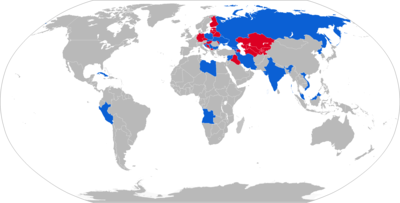R-60 (missile)
This article includes a list of general references, but it lacks sufficient corresponding inline citations. (November 2020) |
| Vympel R-60 AA-8 "Aphid" | |
|---|---|
 | |
| Type | Lightweight short-range air-to-air missile |
| Place of origin | Soviet Union |
| Service history | |
| In service | 1970–present |
| Wars | Iran–Iraq War South African Border War Lebanese Civil War Russian invasion of Ukraine |
| Production history | |
| Manufacturer | Vympel |
| Specifications | |
| Mass | 44 kg (97 lb) |
| Length | 2,090 mm (6 ft 10 in) |
| Diameter | 120 mm (4.7 in) |
| Wingspan | 390 mm (15 in) |
| Warhead | 3 kg (6.6 lb) |
Detonation mechanism | proximity |
| Engine | Solid-fuel rocket engine |
Operational range | 8 kilometres (5.0 mi) |
| Flight altitude | 20,000 m (66,000 ft) |
| Maximum speed | Mach 2.47 |
Guidance system | Infrared homing[1] |
Launch platform | MiG-21, MiG-23, MiG-25, MiG-27, MiG-29, MiG-31, Su-15, Su-17, Su-20, Su-22, Su-24, Su-25, Yak-28, Yak-38, Yak-141, Mi-24, BAE Systems Hawk, L39ZA, J-22 Orao |
The Molniya (now Vympel) R-60 (NATO reporting name: AA-8 "Aphid") is a short-range lightweight infrared homing air-to-air missile designed for use by Soviet fighter aircraft. It has been widely exported, and remains in service with the CIS and many other nations.
History
[edit]The R-60 was initially developed for the MiG-23. Work began on the weapon, under the bureau designation K-60 (izdeliye 62), in the late 1960s. Series production began in 1973. It entered service with the designation R-60 (NATO reporting name "Aphid-A").
When introduced, the R-60 was one of the world's lightest and most agile air-to-air missiles, with a launch weight of 44 kg (97 lb). It has infrared guidance, with an uncooled Komar (Mosquito) seeker head. Control is by forward rudders with large rear fins. The distinctive canards on the nose, known as "destabilizers," serve to improve the rudders' efficiency at high angles of attack. The R-60 uses a small, 3 kg (6.6 lb) tungsten expanding-rod surrounding a high explosive fragmentation warhead. Two different types of proximity fuze can be fitted: the standard Strizh (Swift) optical fuse, which can be replaced with a Kolibri active radar fuse. Missiles equipped with the latter fuse were designated R-60K.[2]
According to Russian sources,[which?] practical engagement range is about 4,000 m (4,400 yd), although "brochure range" is 8 km (5.0 mi) at high altitude. The weapon was one of the most agile air-to-air missiles until the advent of thrust vectored missiles like the R-73 and AIM-9X. The R-60 can be used by aircraft maneuvering at up to 9g against targets maneuvering at up to 8g. A tactical advantage is the short minimum range of only 300 m (330 yd).
Soviet practice was to manufacture most air-to-air missiles with interchangeable IR-homer and semi-active radar homing (SARH) seekers – however, an SARH version of the R-60 was never contemplated due to the small size of the missile which makes a radar-homing version with an antenna of reasonable size impractical.
An inert training version, alternatively designated UZ-62 and UZR-60, was also built.
An upgraded version, the R-60M (NATO reporting name: "Aphid-B"), using a nitrogen-cooled seeker with an expanded view angle of ±20°, was introduced around 1982. Although its seeker is more sensitive than its predecessor, the R-60M has only limited all-aspect capability. Minimum engagement range was further reduced, to only 200 m (220 yd).[3] The proximity fuzes had improved resistance to ECM, although both optical and radar fuzes remained available. The export version with the Kolibri-M Radar-fuze are designated R-60MK (NATO reporting name: "Aphid-C").[4] The R-60M is 42 mm (1.7 in) longer, and has a heavier, 3.5 kg (7.7 lb) continuous-rod warhead, increasing launch weight to 45 kg (99 lb). In the R-60M the continuus rod warhead now uses 1.6 kg (3.5 lb) of depleted uranium rods for enhanced fragmentation.[5]
The inert training version of the R-60M was the R-60MU.

Since 1999, a modified version of the weapon has been used as a surface-to-air missile (SAM) as part of the Yugoslav M55A3B1 towed anti-aircraft artillery system. It has also been seen carried on a twin rail mount on a modified M53/59 Praga armored SPAAG of (former) Czechoslovakian origin. These missiles have been modified with the addition of a first stage booster motor, with the missile's own motor becoming the sustainer. This was done in lieu of modifying the missile's motor for ground launch, as in the case of the US MIM-72 Chaparral.
The current Russian dogfight missile is the R-73 (AA-11 "Archer"), but large numbers of R-60 missiles remain in service.
Operational history
[edit]Soviet Union
[edit]On 20 April 1978, two R-60 missiles were fired at Korean Air Lines Flight 902 after a navigational error had caused it to fly into Soviet airspace. One missile hit, detaching 4 meters of the left wing and killing 2 passengers. The plane made an emergency landing on a frozen lake.[6]
On 21 June 1978, a PVO MiG-23M flown by Pilot Captain V. Shkinder shot down two Iranian Boeing CH-47 Chinook helicopters that had trespassed into Soviet airspace, one helicopter being dispatched by two R-60 missiles and the other by cannon fire.
Syria
[edit]Several Russian reports affirm the R-60 was widely used during the 1982 Lebanon war, and it was the main weapon used by the Syrians in air-to-air combat. Some Russian reports affirm that the R-60 was the most successful air-to-air missile deployed by the Syrians in Lebanon over the Bekaa Valley.[7][8] According to Israeli reports, the vast majority of air-to-air combat consisted of visual range dogfights, and this has been also confirmed by Russian sources. The Russian reports also mentioned that several F-4s, F-16s, and IAI Kfirs were destroyed by R-60s among other aircraft. Israel claims some F-4s and Kfirs were lost in 1982, but lists surface-to-air missiles as responsible for all Israeli aircraft losses. However, on 9 June 1982, a Syrian MiG-21 heavily damaged an F-15 using an R-60, but the Israeli aircraft was able to make it back to its base and was subsequently repaired.[9]
Iraq
[edit]On 11 August 1984, during the Iran–Iraq War, an Iraqi Air Force MiG-23ML shot down an Iranian F-14A piloted by Hashem All-e-Agha using an R-60.[10]
Iraqi MiG-23s damaged two EF-111A Raven by R-60 (missile)s during the Gulf War.[11]
On 19 January 1991, during the Gulf War, Iraqi air force pilot Jameel Sayhood claimed to have shot down a Royal Air Force Panavia Tornado with an R-60 missile. However, the Royal Air Force claimed that the aircraft crashed on 22 January 1991 on a bombing mission in Ar Rutba.
Angola/Cuba
[edit]On 27 September 1987, during Operation Moduler, two Cuban FAR MiG-23MLs intercepted Captain Arthur Piercy's Mirage F1CZ, which was damaged by an R-60 fired head-on by Major Alberto Ley Rivas. The explosion destroyed the aircraft's drag chute and damaged the hydraulics. Piercy was able to recover to AFB Rundu, but the aircraft overshot the runway. The impact with the rough terrain caused Piercy's ejection seat to fire, but he failed to separate from the seat and suffered major spinal injuries.[12][9]
India
[edit]In 1999, an Indian Air Force MiG-21 used an infrared-homing R-60 to bring down a Pakistani Navy Breguet Atlantic which intruded over Indian airspace. Part of the wreckage was found in contested territory, this incident is widely known as the Atlantic incident.
Ukraine
[edit]In 2024, the R-60 has seen some minor use by the Armed Forces of Ukraine during the Russian invasion, being reportedly adapted for the surface-to-air role and mounted on Sea Baby naval drones. The R-60M has also been mounted on Su-25s, possibly for shooting down drones.[13][14]
Operators
[edit]
Current operators
[edit] Algeria[15]
Algeria[15] Angola[16]
Angola[16] Azerbaijan[17]
Azerbaijan[17] Belarus[18]
Belarus[18] Cuba[19]
Cuba[19] Eritrea[20]
Eritrea[20] Ethiopia[21]
Ethiopia[21] Georgia[22]
Georgia[22] India[23]
India[23] Iran[24]
Iran[24] Kazakhstan[25]
Kazakhstan[25] Libya[26]
Libya[26] North Korea[27]
North Korea[27] Peru[28]
Peru[28] Poland[29]
Poland[29] Russia − Used by the Air Force and Naval Aviation[30]
Russia − Used by the Air Force and Naval Aviation[30] Serbia[31]
Serbia[31] Sudan[32]
Sudan[32] Syria[33]
Syria[33] Turkmenistan[34]
Turkmenistan[34] Ukraine[35]
Ukraine[35] Uzbekistan[36]
Uzbekistan[36] Vietnam[37]
Vietnam[37]
Former operators
[edit] Afghanistan[38]
Afghanistan[38] Bulgaria[38]
Bulgaria[38] China[38]
China[38] Croatia − R-60 and R-60MK[39]
Croatia − R-60 and R-60MK[39] Czechoslovakia[40] − Passed on to successor states.
Czechoslovakia[40] − Passed on to successor states. Czech Republic[41]
Czech Republic[41] East Germany[42]
East Germany[42] Finland − Was used on the MiG-21bis[40]
Finland − Was used on the MiG-21bis[40] Germany[38]
Germany[38] Hungary[38]
Hungary[38] Iraq[43]
Iraq[43] Malaysia[38]
Malaysia[38] Romania[38]
Romania[38] Slovakia[38]
Slovakia[38] Soviet Union[44] − Passed on to successor states.
Soviet Union[44] − Passed on to successor states. South Yemen[40]
South Yemen[40] Yemen[45]
Yemen[45] Yugoslavia[38] − Passed on to successor states.
Yugoslavia[38] − Passed on to successor states. Zimbabwe[46]
Zimbabwe[46]
References
[edit]- Citations
- ^ (in Ukrainian) Spring of 1978. How USSR downed over Karelia the Korean "Boeing". (The homing device was produced at the Kiev Arsenal factory.)
- ^ Gordon, Yefim, Soviet/Russian Aircraft Weapons Since World War Two (Hinckley, England: Midland Publishing, 2004), pp. 29–32.
- ^ Mladenov, Alexander, "Air-to-air missiles for the fighter 'Flogger'", International Air Power Review vol. 14, 2004, pp. 90–91.
- ^ "R-60MK". astronautix.com. Archived from the original on 25 June 2017. Retrieved 8 December 2021.
- ^ "Health Risks of Using Depleted Uranium," Venik's Aviation, 2001.
- ^ "Весна 1978-го. Як СРСР збив над Карелією корейський "боїнг". ФОТО" [Spring 1978. How the USSR shot down a Korean Boeing over Karelia. PHOTO]. Ukrayinska Pravda (in Ukrainian). 4 May 2012. Retrieved 31 May 2022.
- ^ SyAAF MiG-23 combat record. Archived 16 January 2014 at the Wayback Machine
- ^ "-23". Retrieved 23 December 2014.
- ^ a b "Piloto SAAF derribado por MiG-23 cubano". Archived from the original on 7 September 2014. Retrieved 20 December 2008.
- ^ Cooper 2018, p. 36
- ^ https://web.archive.org/web/20091111151554/http://s188567700.online.de/CMS/index.php?option=com_content&task=view&id=37&Itemid=47 [bare URL]
- ^ Lord, Dick (2000). Vlamgat: The Story of the Mirage F1 in the South African Air Force. Covos-Day. ISBN 0-620-24116-0.
- ^ Newdick, Thomas (6 May 2024). "Ukrainian Drone Boats Now Armed With Adapted Air-To-Air Missiles". The War Zone. Retrieved 14 December 2024.
- ^ Newdick, Thomas (17 April 2024). "Ukraine Situation Report: Russian Air Defense Systems Struck In Crimea". The War Zone. Retrieved 14 December 2024.
- ^ IISS 2024, p. 344.
- ^ IISS 2024, p. 472.
- ^ IISS 2024, p. 181.
- ^ IISS 2024, p. 183.
- ^ IISS 2024, p. 429.
- ^ IISS 2024, p. 490.
- ^ IISS 2024, p. 492.
- ^ "Fighter SU-25KM (Scorpion)". Archived from the original on 27 May 2016. Retrieved 23 December 2014.
- ^ IISS 2024, p. 270.
- ^ IISS 2024, p. 356.
- ^ IISS 2024, p. 187.
- ^ IISS 2024, p. 371.
- ^ IISS 2024, p. 284.
- ^ IISS 2024, p. 449.
- ^ IISS 2024, p. 127.
- ^ IISS 2024, pp. 198, 200.
- ^ IISS 2024, p. 134.
- ^ IISS 2024, p. 522.
- ^ IISS 2024, p. 387.
- ^ IISS 2024, p. 209.
- ^ IISS 2024, p. 213.
- ^ IISS 2024, p. 216.
- ^ IISS 2024, p. 326.
- ^ a b c d e f g h i Lennox, Duncan, ed. (1997). "AA-8 'Aphid' (R-60)". Jane's Air-Launched Weapons (35th ed.). Surrey: Jane's Information Group.
- ^ IISS 2024, p. 80.
- ^ a b c "Arms transfer database". SIPRI. Stockholm International Peace Research Institute. Retrieved 3 August 2024.
- ^ Gordon & Komissarov 2019, p. 372
- ^ Gordon & Komissarov 2019, p. 446
- ^ Cooper 2018, p. 23
- ^ Gordon & Komissarov 2019, p. 193
- ^ Cooper, Tom (2018). Hot Skies Over Yemen, Volume 2: Aerial Warfare Over the South Arabian Peninsula, 1994-2017. Warwick, UK: Helion & Company Publishing. p. 67. ISBN 978-1-911628-18-7.
- ^ Cooper et al. 2011, p. 214
- Bibliography
- Cooper, Tom (2018). MiG-23 Flogger in the Middle East, Mikoyan i Gurevich MiG-23 in Service in Algeria, Egypt, Iraq, Libya and Syria, 1973-2018. Warwick: Helion & Company Publishing. ISBN 978-1-912-390328.
- Cooper, Tom; Weinert, Peter; Hinz, Fabian; Lepko, Mark (2011). African MiGs, Volume 2: Madagascar to Zimbabwe. Houston: Harpia Publishing. ISBN 978-0-9825539-8-5.
- Gordon, Yefim (2004). Soviet/Russian Aircraft Weapons Since World War Two. Hinckley, England: Midland Publishing. ISBN 1-85780-188-1.
- Gordon, Yefim; Komissarov, Dmitriy (2019). Mikoyan MiG-23 & MiG-27. Manchester: Crécy Publishing. ISBN 978-1-91080-931-0.
- International Institute for Strategic Studies (2024). The Military Balance 2024. Taylor & Francis. ISBN 978-1-040-05115-3.
- Mladenov, Alexander (2015). Su-25 'Frogfoot' Units in Combat. Oxford: Osprey Publishing. ISBN 978-1-4728-0567-6.
